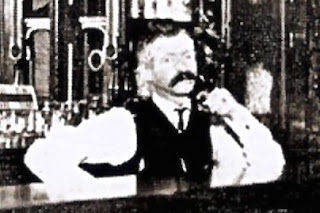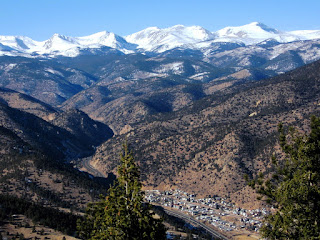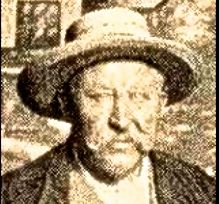Solomon "Sol" Weinberger, Idaho Springs, Colorado
Shown here standing behind the bar of his saloon, Solomon “Sol” Weinberger was a diminutive five feet, three inches, tall. His height had little to do with his reputation in Idaho Springs, Colorado, as a genial proprietor and civic-minded citizen of his adopted country.
 The diminutive Sol was born in July 1864 in a part of Europe then in the Austro-Hungarian Empire, the son of Abraham and Henche Weinberger. At the age of 17 he emigrated to the United States, arriving in June 1881 aboard the steamer Normannia, shown here. In that move Sol apparently had been preceded by an elder brother, Simon, and two half-brothers, Herman and Nathan, all of whom had settled in Colorado, Simon in boom town Cripple Creek where he was running a saloon.
The diminutive Sol was born in July 1864 in a part of Europe then in the Austro-Hungarian Empire, the son of Abraham and Henche Weinberger. At the age of 17 he emigrated to the United States, arriving in June 1881 aboard the steamer Normannia, shown here. In that move Sol apparently had been preceded by an elder brother, Simon, and two half-brothers, Herman and Nathan, all of whom had settled in Colorado, Simon in boom town Cripple Creek where he was running a saloon.
Records indicate that Sol, a bachelor, may have been working in Simon’s saloon and living with Simon’s family that included his wife, Bettie, and son Bernard. In Cripple Creek Weinburger met his future wife, Anna Glauber, a woman who had immigrated to Colorado from Hungary. When they married in April 1892 he was 28 and she was 27. They would have a family of two sons and a daughter: Maurice “Morrie” born in 1893, Wilhemina “Minnie” a year later, and Alvin in 1905.
By 1900 indications are that Sol had left Simon’s employ and struck out on his own, opening a liquor business. The 1900 census found him in Cripple Creek and recorded his occupation as “wholesale liquor.” For reasons undisclosed, not long after Sol pull up stakes there and moved his family 105 miles north to Idaho Springs, in Clear Creek County, Colorado, about 30 miles west of Denver.
Idaho Springs, shown here as it looks today, had been the site of the Pike’s Peak Gold Rush, the state’s first gold strike. Findings of gold in stream beds were soon followed by discoveries of rich veins in the rocks of the canyon walls on both sides of Clear Creek.
 Underground mining for valuable metals and minerals became the mainstay of the town long after the gold-bearing gravels were exhausted. As a result, Idaho Springs continued into the 20th Century with a healthy economy. An early photo captures dozens of wagon hauling ore and other goods down the town’s main drag, Miner Street.
Underground mining for valuable metals and minerals became the mainstay of the town long after the gold-bearing gravels were exhausted. As a result, Idaho Springs continued into the 20th Century with a healthy economy. An early photo captures dozens of wagon hauling ore and other goods down the town’s main drag, Miner Street.
In Idaho Springs, Weinberger opened his saloon and liquor store. A photo of the interior shows him with four customers, none of whom seem to be drinking. He has installed or inherited a fancy carved bar with an unusual elaborate tower that held bottles of liquor. The usual foot rail and spitoons are in evidence and an array of glasses reflected in the large mirror. From his facial expression and body language, Sol looks somewhat discomfited by having his picture taken.
Called the Weinberger Liquor Company, the saloon and store stood at 1630 Miner Street. The building reportedly was owned by Simon. Nathan and Jacob also may have had saloons in town.
Sol appears rapidly to have gained popularity in Idaho Springs as a saloonkeeper, providing strong drink to thirsty miners. He gave a healthy five cent token to regular customers, always a way to gain acclaim among the populace. As this mining camp evolved into a town whose main street is now on the National Register of Historical Places, Weinberger became known for his civic contributions.
 His wholesale and retail whiskey sales proved lucrative. A railroad financed by Jay Gould, head Union Pacific, had reached Idaho Springs in 1877, opening access to freight. As a result, Weinberger could obtain shipments of whisky in barrels through Denver. Sol would decant them into one and two gallon ceramic jugs and sell them to the many other saloons that inhabited the town. As shown here, those containers varied from very rough pottery with crudely stenciled labels to more crafted stoneware jugs with lettering under an Albany slip glaze.
His wholesale and retail whiskey sales proved lucrative. A railroad financed by Jay Gould, head Union Pacific, had reached Idaho Springs in 1877, opening access to freight. As a result, Weinberger could obtain shipments of whisky in barrels through Denver. Sol would decant them into one and two gallon ceramic jugs and sell them to the many other saloons that inhabited the town. As shown here, those containers varied from very rough pottery with crudely stenciled labels to more crafted stoneware jugs with lettering under an Albany slip glaze.
Sol’s containers are avidly collected today: The jug above left recently fetched $332 at auction. Weinberger also was selling whiskey at retail, using glass flasks holding a pint of liquor. The bottle shown here with embossing of his name and location are indicative of his healthy trade. Embossed bottles cost more than plain glass with a paper label.
 Although Idaho Springs continued to exhibit a buoyant economy into the 20th Century, prohibition was making a statement in Colorado, first through local option laws and then a state law establishing a total ban on making or selling alcoholic beverages. On January 1, 1916 — four years before National Prohibition — Colorado went “dry.” Sol had no choice but to shut down his saloon and liquor business. But he wasted no time in making another move.
Although Idaho Springs continued to exhibit a buoyant economy into the 20th Century, prohibition was making a statement in Colorado, first through local option laws and then a state law establishing a total ban on making or selling alcoholic beverages. On January 1, 1916 — four years before National Prohibition — Colorado went “dry.” Sol had no choice but to shut down his saloon and liquor business. But he wasted no time in making another move.
Taking his profits from his Idahol Springs saloon, Weinberger said goodbye to Colorado for “wet” California, settling in San Francisco. The 1920 Census found him there, living on Hyde Street with Anna and their two sons. Sol gave his occupation as “oyster salesman.” Not long after, however, with Theodore Glauber, a relative of his wife, Weinberger opened a restaurant at 1510 Fillmore Street. This was soon followed by a second eatery in which he appears to have been sole proprietor, located at 1106 Market Street.
 The San Francisco restaurant business must have been profitable for Weinberger. By 1933 he had moved with his wife to this elegant large townhouse cum condo and at 69 years old, retired. In 1937, Anna died at age 72 and was buried in Hills of Eternity Memorial Park in Colma, outside San Francisco.
The San Francisco restaurant business must have been profitable for Weinberger. By 1933 he had moved with his wife to this elegant large townhouse cum condo and at 69 years old, retired. In 1937, Anna died at age 72 and was buried in Hills of Eternity Memorial Park in Colma, outside San Francisco.  Sol lived on another 15 years, dying at the age of 87 in June 1952. His small stature and labors in the hardscrabble America West clearly had not proved an impediment to longevity. His grave lies adjacent to Anna’s.
Sol lived on another 15 years, dying at the age of 87 in June 1952. His small stature and labors in the hardscrabble America West clearly had not proved an impediment to longevity. His grave lies adjacent to Anna’s.
Note: The photo above of Sol Weinberger in his saloon has fascinated me for its depiction of the distinctly slight immigrant proprietor holding his own among the rough and tumble residents of a sometimes rowdy Western mining town. It was displayed on the web in 2014 by a great-grandson, Mark Weinberger, who was operating a local history museum outside San Francisco. He in turn credited Marjorie Bell of the Idaho Springs Historical Society for finding the photo, dated circa 1915.











Comments
Post a Comment